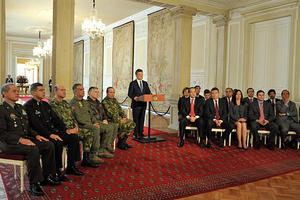The composition of any negotiating team reveals facts about the importance of the negotiations, the nature of those negotiations, and their prospects for success. Drawing on this understanding, we can make some educated guesses about what to expect from the upcoming negotiations between the Colombian state and the Revolutionary Armed Forces of Colombia (FARC).
In sharp contrast with the failed 1998-2002 negotiations and the efforts of President Belisario Betancur (1982-1986), the forthcoming negotiations wil involve the direct representation of the military and representatives of the business elite. This time around President Juan Manuel Santos has named two hard-line retired generals to participate in the talks, the first is Oscar Naranjo, who commanded the police until June 2012, playing a crucial role in the operations that killed the two FARC’s leaders, Raul Reyes, and Mono Jojoy. Naranjo will be accompanied by General Jorge Enrique Mora, also known as a hard liner within the military. He commanded the Army during the presidency of Andres Pastrana (1998-2002), and became the commander of the Armed forces from 2002 to 2003, during the first term of the government of Alvaro Uribe Velez (2002-2010).

The participation of these two generals will comfort the military establishment, knowing that any deal reached with FARC must obtain their acquiescence. This is an important component that may help this peace effort by reducing the resistance of an establishment that was instrumental in derailing the previous peace attempts of 1982 and 1998. During the first peace attempt, the military launched the infamous attack on the Palace of Justice after the guerrillas of the defunct M-19 occupied the building, taking the Supreme Court Justices as hostages. The military attack led to the killing of most of the hostages—rebels and judges alike—bringing to a dramatic halt to the Betancur peace process. Some claim that this military attack was a virtual coup against Betancur’s peace overture. Again during Pastrana’s 1998-2002 attempt, the military, in alliance with the paramilitary and the support of the United States, preempted any possible solution that might favor the insurgents’ demands that structural economic changes be introduced that would change property relations and the neoliberal economic model of development.
Learning from these previous ill-fated experiences, President Santos is attempting to avoid the past negative outcomes. To Santos's credit he also appointed the son of a military officer—born in the barracks—to be Minister of Defense, further putting the military at ease. Minister Pinzon is a savvy technocrat, conscious that the expansion of the military, at an exorbitant cost of $14 billion for 2013, is yielding diminishing returns as the rate of fatalities is demonstrating. He seems to be on the same pragmatic page as Santos.
Finally, Santos wanted to secure the backing of the business elite by bringing on board Luis Carlos Villegas, the president of National Association of Industries (ANDI) as one of the chief negotiators. In the previous peace talks, the ANDI was represented at a lower level and only intermittently. This again is a move to secure the support of important sectors of the dominant class. Moreover, the government’s team includes Humberto de la Calle, an important figure who participated in the constituent assembly of 1991. A jurist and reformist, de la Calle represents the enlightened bourgeois impulse of Santos, along with Sergio Jaramillo and Frank Pearl. These two latter are close associates of Santos, familiar with the intricacies of the conflict.
Thus far, the only important missing actors are the cattle ranchers and large landowners who are expected to resist to the best of their abilities a peace that could bring a meaningful land reform. The high concentration of landed properties has been the cornerstone of this five-decade-long armed conflict and its corresponding war system. It must be the very first item in peace talks.
In my next blog I will analyze the composition of the FARC negotiating team, drawing some further conclusions.
Stay tuned.
Nazih Richani is the Director of Latin American studies at Kean University. He blogs at nacla.org/blog/cuadernos-colombianos.

